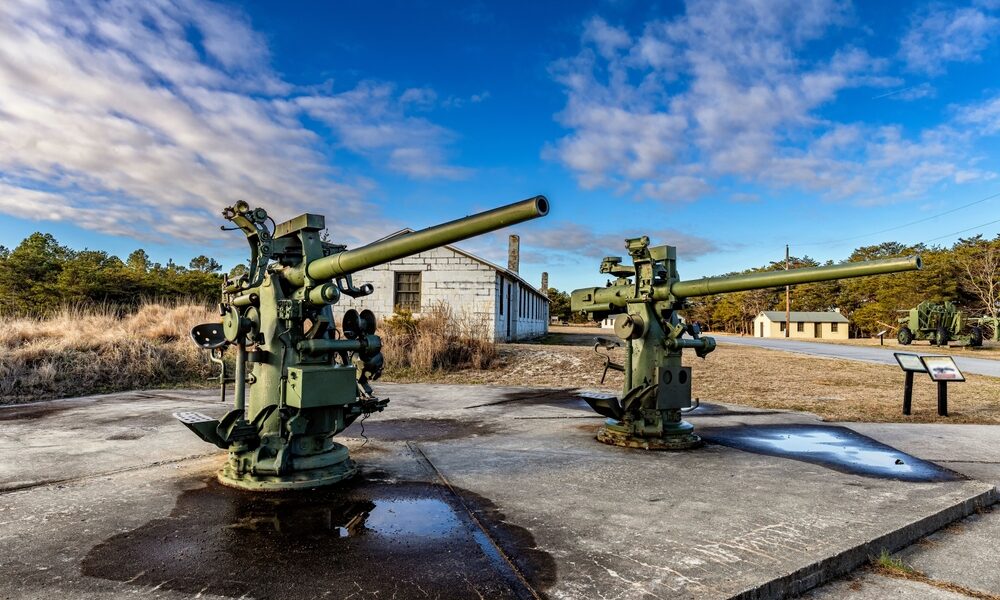
Fort Miles, Delaware
Right along the shores where Delaware Bay meets the Atlantic Ocean sits Fort Miles, a cool piece of American military history that many travelers miss.
This former defense site was crucial during World War II and is now a historical park that mixes military artifacts with natural beauty. Fort Miles offers something different whether you’re into history, love the outdoors, or just want to explore something new in Delaware.

This Old Army Base Now Teaches Military History
This old U.S. Army defense site now operates as a historical area in Cape Henlopen.
The fort features restored gun batteries, underground bunkers, and the Fort Miles Museum inside the massive Battery 519. Built to protect Delaware Bay from German naval attacks, it’s now one of Delaware’s most interesting historical spots.
You can explore artillery displays, original buildings, and interactive exhibits that tell the story of Fort Miles’ key role in America’s coastal defense system.

The Fort Was Built to Stop German Ships
Fort Miles was built between 1941 and 1943 as America entered World War II to defend Delaware’s coast.
The fort was strategically placed to protect Philadelphia’s ports and oil refineries from possible German naval attacks coming up the Delaware Bay.
At its busiest, Fort Miles housed about 2,500 military personnel and had huge 16-inch guns that could fire shells over 25 miles away.
The fort’s impressive firepower was meant to keep enemy ships from approaching the important shipping channels of the Delaware River and Bay.

A German Submarine Surrendered Here in 1945
Famously, it served integral to the surrender of German submarine U-858 in May 1945. The U-boat’s Enigma machine and other items from the surrender are on display in the museum.
This was the only time during World War II that an enemy submarine surrendered on American soil. After Germany’s defeat, the U-boat surfaced off Cape Henlopen and was brought to Fort Miles where the crew formally surrendered.
Today, a special exhibit in the museum shows this historic event with photos, artifacts, and stories from people who were there.

Battery 519 Has Walls 25 Feet Thick
Battery 519 is the centerpiece of Fort Miles Historical Area and houses the main museum.
This huge concrete fortification has walls 25 feet thick, built to withstand heavy bombing. Originally made to house two 12-inch guns, the battery is now a museum experience.
You can explore the large rooms that were once used for storing ammunition, plotting targets, and housing personnel.
The cool, dim corridors create an atmospheric journey back in time, with real equipment, furnishings, and displays that bring the fort’s wartime operations to life.

Climb a Real World War II Lookout Tower
One of Fort Miles’ standout features is its network of concrete observation towers along the Delaware coastline.
Eleven of these towers still stand today, with Tower 7 at Cape Henlopen restored and open to visitors. These 75-foot concrete towers served as the eyes of Fort Miles, with spotters using special optical equipment to track potential enemy ships.
When you climb the spiral staircase to the top of Tower 7, you’ll see amazing panoramic views of the Atlantic Ocean, Delaware Bay, and surrounding areas—the same views that soldiers once watched for approaching threats during the war.

The 114-Ton Big Bertha Gun Comes from a German Ship
In 2012, Fort Miles got a real German 16-inch gun barrel from the battleship Prinz Eugen, nicknamed “Big Bertha” by visitors.
This massive artillery piece weighs over 114 tons and stretches 60 feet long, making it an impressive centerpiece for the fort’s outdoor artillery park.
The gun came to Fort Miles through community fundraising and was transported from Norfolk Naval Shipyard in Virginia.
Along with American artillery pieces, this German gun helps visitors connect with the weapons technology of World War II and the threats Fort Miles was built to counter.

Staff Dress as World War II Soldiers
Interpreters in authentic WWII uniforms demonstrate equipment, explain daily operations, and share soldiers’ stories, including the artillery demonstrations, signal communications, and barrack life.
On special event weekends, you might experience nighttime lantern tours, mock coastal defense drills, or even a reenactment of the U-858 surrender.

Secret Tunnels Run Under the Fort
Beneath Fort Miles lies a network of underground tunnels and bunkers that once connected various batteries and operational areas.
These reinforced concrete passageways let personnel move safely during potential attacks and provided secure areas for ammunition storage and command operations.
Limited guided tours of these underground corridors give you a fascinating look at the fort’s defensive design. The bunkers stay cool year-round, offering relief during hot summer visits while adding some adventure to your historical exploration.

From War Fort to State Park
After World War II ended, Fort Miles became less important militarily. The site briefly served as a training facility before closing in 1958. The land was later given to Delaware and became part of Cape Henlopen State Park in 1964.

Sand Dunes Surround Old Military Bunkers
Another thing that makes Fort Miles special is its stunning natural setting in Cape Henlopen State Park.
The fort’s military structures sit among beautiful coastal landscapes with rolling sand dunes, forests, and scenic beaches. You can combine your history exploration with outdoor activities like hiking, biking, bird watching, or beachcombing.

Visiting Fort Miles
Fort Miles Historical Area is located in Cape Henlopen State Park, just outside Lewes, Delaware.
- Park hours: Open daily from 8 AM to sunset
- Entry fees: $5 for Delaware vehicles and $10 for out-of-state visitors
- Guided tours: $6 per person (free for veterans and active-duty military)
For the latest information, check the Delaware State Parks website or call ahead.
The post The Delaware Military Base That Captured a German Submarine Without Firing a Single Shot in 1945 appeared first on When In Your State.




![Tyson Foods Plant [Photo: Food Manufacturing]](https://southarkansassun.com/wp-content/uploads/2023/08/iStock_1185520857__1_.5e441daa51cca-600x337.jpg)







![Silverado Senior Living Management Inc. [Photo: Los Angeles Times]](https://southarkansassun.com/wp-content/uploads/2023/10/download-6-4-600x337.jpg)

![China's Wuhan Institute of Virology [Photo: Nature]](https://southarkansassun.com/wp-content/uploads/2023/09/d41586-021-01529-3_19239608-600x337.jpg)
















